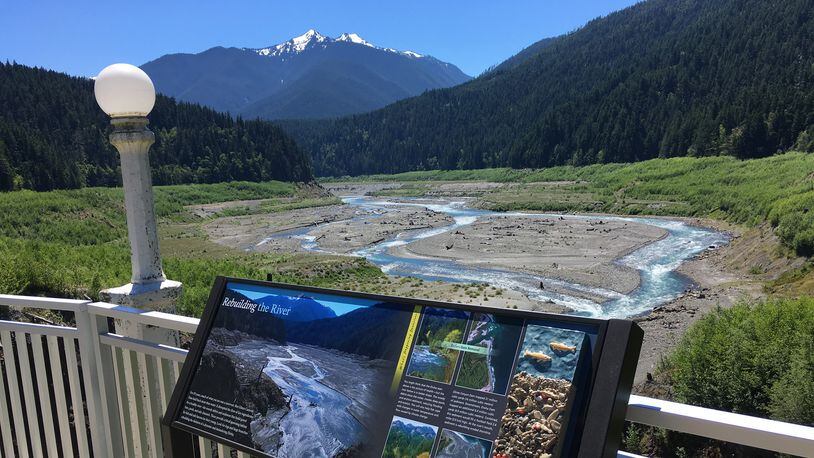Visitors can perch on an overlook made from remnants of the former Glines Canyon Dam, and look down 210 feet to where the Elwha River now rushes past in a foaming green slide. Recordings and interpretive signs along the viewing platform explain the project that began with the removal of Elwha Dam in 2011 and continued with the takedown of Glines Canyon Dam, completed in 2014.
The Glines Canyon Overlook is handicapped-accessible, and offers expansive views of the Elwha River above and below the former dam site. A marked trail to the riverbed departs from the overlook.
It winds past stumps of old-growth trees cut before the dam was built, and the new forest rising on the former lake bed.
Lupine along the trail have been a surprising star of the recovery project. Purple, fragrant carpets of the flower in the former Lake Mills are alive with white-crowned sparrows, nesting and singing. The flowers buzz with pollinators.
Lupine fix nitrogen from the air in their roots and leaves, and are helping to nourish the ground, said Josh Chenoweth, restoration botanist for the park.
Raised from seed gathered in the Dungeness River valley, the lupine was sowed for the first time in 2013, and has flourished ever since. It is providing just the wind break, shade and food other plants need. “It’s been really important, and instead of hindering other plants this very aggressive species has really helped. It’s pretty spectacular,” Chenoweth said.
Trees growing nearby are noticeably lusher since the lupine kicked into gear, he noted.
This is the last year of the revegetation program for the Elwha, which has resulted in forests grown more than 20 feet high with more than 1,000 stems per acre of willow, alder and cottonwood on the valley walls — better and faster than anyone expected.
Credit: Doug MacDonald/Seattle Times
Credit: Doug MacDonald/Seattle Times
Cobble, sand and gravel valley bottoms are another story, where the dry, poorly drained areas have more bare ground.
In all, more than 320,000 plants, mostly trees and shrubs, have been planted along with 6,000 pounds of seeds to revegetate the former Lake Aldwell above the Elwha Dam and Lake Mills above Glines Canyon Dam.
Meanwhile, blasting in 2015 and 2016 has helped fish make it higher than ever in the watershed.
Contractors for the National Park Service, which is in charge of the $325 million federal restoration project, blasted rocks at both former dam sites to remove 14 boulders weighing 100 tons or more — two were as tall as a two-story building, and weighed more than 1,000 tons.
The U.S. Army Corps of Engineers in 2016 also removed from the river channel metal and other debris left over from dam removal that had posed a hazard to boaters. More metal removal is planned for this summer.
While the Elwha has been roaring back to life ever since the first dam came down, there is still a long way to go.
“We’ll be another 20 years down the road before we meet fish restoration,” said Doug Morrill, natural-resources director for the Lower Elwha Klallam tribe. “We are seeing progress. But we are in the early stages.” The fishing moratorium imposed on the Elwha was recently extended by state, federal and tribal fish managers for another two years, until June 1, 2019.
The overall return of adult fish to the Elwha is actually down since dam removal began. That is because the fish coming back now went to sea as juveniles during the time of highest sediment loading in the river, just after dam removal. By now the river is back to normal clarity.
“We anticipate seeing a dip in returns over the next several years, as the number of juveniles that went to sea were down in 2013, 2014 and 2015,” said Penny Wagner, acting spokeswoman for Olympic National Park. “After that lull, the river should again experience an increase in abundance that will continue, subject to environmental factors including ocean conditions, until we reach our recovery goals.”
Fish continue to take on more of the 70 miles of spawning habitat returned to them with dam removal, noted Mike McHenry, habitat biologist for the tribe.
Last fall, a single chinook salmon redd was spotted some 36 miles upriver near Godkin Creek. That’s 23 miles upstream of the former Glines Canyon Dam, and the highest up in the watershed since the dam came down. More than 100 chinook redds were seen above Glines last year, the most ever.
Coho also were observed spawning in Cat and Boulder creeks in 2016 for the first time.
One of the most dramatic transformations still underway is the beach that has been building at the river mouth, made of the sediment transported by the Elwha, finally free of the hydropower dams first built in 1910.
“There are three and a half million cubic yards of beautiful Elwha sand there,” McHenry said. “People are crab fishing where they have never fished before.”
About the Author
